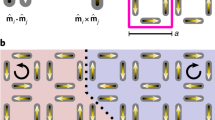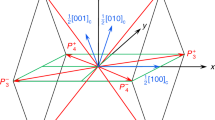Abstract
Ferroelectromagnets are an interesting group of compounds that complement purely (anti-)ferroelectric or (anti-)ferromagnetic materials—they display simultaneous electric and magnetic order1,2,3. With this coexistence they supplement materials in which magnetization can be induced by an electric field and electrical polarization by a magnetic field, a property which is termed the magnetoelectric effect4. Aside from its fundamental importance, the mutual control of electric and magnetic properties is of significant interest for applications in magnetic storage media and ‘spintronics’2,3. The coupled electric and magnetic ordering in ferroelectromagnets is accompanied by the formation of domains and domain walls. However, such a cross-correlation between magnetic and electric domains has so far not been observed. Here we report spatial maps of coupled antiferromagnetic and ferroelectric domains in YMnO3, obtained by imaging with optical second harmonic generation. The coupling originates from an interaction between magnetic and electric domain walls, which leads to a configuration that is dominated by the ferroelectromagnetic product of the order parameters.
This is a preview of subscription content, access via your institution
Access options
Subscribe to this journal
Receive 51 print issues and online access
$199.00 per year
only $3.90 per issue
Buy this article
- Purchase on Springer Link
- Instant access to full article PDF
Prices may be subject to local taxes which are calculated during checkout


Similar content being viewed by others
References
Smolenskii, G. A. & Chupis, I. E. Ferroelectromagnets. Sov. Phys. Usp. 25, 475–493 (1982)
Schmid, H. Ferroelectrics 162, 317–338 (1994)
Hill, N. A. Why are there so few magnetic ferroelectrics? J. Phys. Chem. B 104, 6694–6709 (2000)
O'Dell, T. H. The Electrodynamics of Magneto-Electric Media (North-Holland, Amsterdam, 1970)
Aizu, K. Possible species of ferromagnetic, ferroelectric, and ferroelastic crystals. Phys. Rev. B 2, 754–772 (1970)
Birss, R. R. Symmetry and Magnetism (North-Holland, Amsterdam, 1966)
Yakel, H. L., Koehler, W. C., Bertaut, E. F. & Forrat, E. F. On the crystal structures of the manganese (III) trioxides of the heavy lanthanides and yttrium. Acta Crystallogr. 16, 957–962 (1963)
Bertaut, E. F. & Mercier, M. Structure magnetique de MnYO3 . Phys. Lett. 5, 27–29 (1963)
van Aken, B. B., Meetsma, A. & Palstra, T. T. M. Hexagonal YMnO3 . Acta Crystallogr. C 57, 230–232 (2001)
van Aken, B. B. . Structural Response to Electronic Transitions in Hexagonal and Ortho-Manganites PhD thesis, Reiksuniversiteit Groningen (2001)
Fiebig, M. et al. Determination of the magnetic symmetry of hexagonal manganites by second harmonic generation. Phys. Rev. Lett. 84, 5620–5623 (2000)
Sa, D., Valenti, R. & Gros, C. A generalized Ginzburg-Landau approach to second harmonic generation. Eur. Phys. J. B 14, 301–305 (2000)
Fiebig, M., Fröhlich, D., Leute, S. & Pisarev, R. V. Topography of antiferromagnetic domains using second harmonic generation with an external reference. Appl. Phys. B 66, 265–270 (1998)
Leute, S., Lottermoser, Th. & Fröhlich, D. Nonlinear spatially resolved phase spectroscopy. Opt. Lett. 24, 1520–1522 (1999)
Fujimura, N., Ishida, T., Yoshimura, T. & Ito, T. Epitaxially grown YMnO3 film: new candidate for nonvolatile memory devices. Appl. Phys. Lett. 69, 1011–1013 (1996)
Iizuka-Sakano, T., Hanamura, E. & Tanabe, Y. Second-harmonic-generation spectra of the hexagonal manganites RMnO3 . J. Phys. Cond. Matter 13, 3031–3055 (2001)
Soboleva, T. K. & Stefanovskii, E. P. Equilibrium state of the magnetic subsystem of antiferromagnetic ferroelelctric. Sov. Phys. Solid State 25, 1637–1638 (1983)
Filippetti, A. & Hill, N. A. First-principles study of structural, electronic and magnetic interplay in ferroelectromagnetic yttrium manganite. J. Magn. Magn. Mater. 236, 176–1898 (2001)
Acknowledgements
We thank Y. Tanabe, E. Hanamura and K. Hagita for discussions, and the Deutsche Forschungsgemeinschaft and the Alexander-von-Humboldt-Stiftung for financial support.
Author information
Authors and Affiliations
Corresponding author
Ethics declarations
Competing interests
The authors declare that they have no competing financial interests.
Rights and permissions
About this article
Cite this article
Fiebig, M., Lottermoser, T., Fröhlich, D. et al. Observation of coupled magnetic and electric domains. Nature 419, 818–820 (2002). https://doi.org/10.1038/nature01077
Received:
Accepted:
Issue Date:
DOI: https://doi.org/10.1038/nature01077
This article is cited by
-
Effect of Lanthanum on Structural, Dielectric, Electrical, and Optical Properties of the Bismuth Ferrite
Brazilian Journal of Physics (2024)
-
Magnetic, electric and magnetocaloric properties of EuFe0.5Mn0.5O3 perovskite: Monte Carlo study and ab-initio calculations
Journal of the Korean Ceramic Society (2024)
-
Effect of Gd3+ substitution on structural, morphological, and magnetic properties of BiFeO3 nanoparticles
Journal of Sol-Gel Science and Technology (2024)
-
Multi-state data storage in a two-dimensional stripy antiferromagnet implemented by magnetoelectric effect
Nature Communications (2023)
-
Domain-wall magnetoelectric coupling in multiferroic hexagonal YbFeO3 films
Scientific Reports (2023)
Comments
By submitting a comment you agree to abide by our Terms and Community Guidelines. If you find something abusive or that does not comply with our terms or guidelines please flag it as inappropriate.



